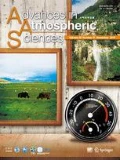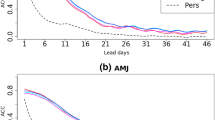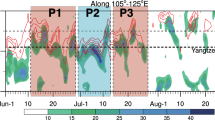Abstract
Based on the reforecast data (1999–2010) of three operational models [the China Meteorological Administration (CMA), the National Centers for Environmental Prediction of the U.S. (NCEP) and the European Centre for Medium-Range Weather Forecasts (ECMWF)] that participated in the Subseasonal to Seasonal Prediction (S2S) project, we identified the major sources of subseasonal prediction skill for heatwaves over the Yangtze River basin (YRB). The three models show limited prediction skills in terms of the fraction of correct predictions for heatwave days in summer; the Heidke Skill Score drops quickly after a 5-day forecast lead and falls down close to zero beyond the lead time of 15 days. The superior skill of the ECMWF model in predicting the intensity and duration of the YRB heatwave is attributable to its fidelity in capturing the phase evolution and amplitude of high-pressure anomalies associated with the intraseasonal oscillation and the dryness of soil moisture induced by less precipitation via the land-atmosphere coupling. The effects of 10–30-day and 30–90-day circulation prediction skills on heatwave predictions are comparable at shorter forecast leads (10 days), while the biases in 30–90-day circulation amplitude prediction show close connection with the degradation of heatwave prediction skill at longer forecast leads (> 15–20 days). The biases of intraseasonal circulation anomalies further affect precipitation anomalies and thus land conditions, causing difficulty in capturing extremely hot days and their persistence in the S2S models.
摘要
次季节预测是衔接中短期预报与气候预测的纽带, 是发展无缝隙天气–气候预报系统的重要环节, 然而当今业务模式对次季节预测的能力相对薄弱。了解次季节可预报性来源, 进而提高灾害天气的次季节预测技巧, 是国际前沿科学难题。WMO次季节–季节(S2S)预测计划的多模式数据库为探索灾害天气次季节预测的潜在可预报性提供了机会。本文利用S2S计划的三家业务预报中心模式(CMA、NCEP、ECMWF)回报数据, 评估并诊断了影响长江流域热浪次季节可预报性的关键因子。结果表明, 当模式准确预测出西北太平洋上季节内尺度高压异常的位相演变和振幅, 及相应的环流和降水改变所导致土壤湿度变化时, 其对热浪的发生、强度与持续时间有较高预报技巧。不同频段的次季节环流预报技巧偏差对热浪预测的影响存在差异, 当预报提前时间较短时(提前10天), 10–30d和30–90d环流预报技巧对热浪预测的影响相当, 然而在预报提前时间较长时(提前15–20d以上), 30–90d环流预报的偏差是导致热浪预报技巧下降的关键因素。季节内环流异常的偏差再通过影响降水异常调制土壤状态, 使模式中缺乏支持高温增强的有利条件。
Similar content being viewed by others
References
Almeira, G., M. M. Rusticucci, and M. Suaya, 2016: Relacion entre mortalidad y temperaturas extremas en buenos aires y rosario. Meteorologica, 41, 65–79.
Black, E., M. Blackburn, G. Harrison, B. Hoskins, and J. Methven, 2004: Factors contributing to the summer 2003 European heatwave. Weather, 59, 217–223, https://doi.org/10.1256/wea.74.04.
Decker, M., M. A. Brunke, Z. Wang, K. Sakaguchi, X. B. Zeng, and M. G. Bosilovich, 2012: Evaluation of the reanalysis products from GSFC, NCEP, and ECMWF using flux tower observations. J. Climate, 25, 1916–1944, https://doi.org/10.1175/JCLI-D-11-00004.1.
Dee, D. P., and Coauthors, 2011: The ERA-Interim reanalysis: Configuration and performance of the data assimilation system. Quart. J. Roy. Meteor. Soc., 137, 553–597, https://doi.org/10.1002/qj.828.
Dirmeyer, P. A., C. A. Schlosser, and K. L. Brubaker, 2009: Precipitation, recycling, and land memory: An integrated analysis. Journal of Hydrometeorology, 10, 278–288, https://doi.org/10.1175/2008JHM1016.1.
Fischer, E. M., S. I. Seneviratne, P. L. Vidale, D. Lüthi, and C. Schär, 2007: Soil moisture-atmosphere interactions during the 2003 European summer heat wave. J. Climate, 20, 5081–5099, https://doi.org/10.1175/JCLI4288.1.
Ford, T. W., P. A. Dirmeyer, and D. O. Benson, 2018: Evaluation of heat wave forecasts seamlessly across subseasonal timescales. npj Climate and Atmospheric Science, 1, 20, https://doi.org/10.1038/s41612-018-0027-7.
García-Herrera, R., J. Díaz, R. M. Trigo, J. Luterbacher, and E. M. Fischer, 2010: A review of the European summer heat wave of 2003. Critical Reviews in Environmental Science and Technology, 40, 267–306, https://doi.org/10.1080/10643380802238137.
He, Z., P. C. Hsu, X. W. Liu, T. W. Wu, and Y. X. Gao, 2019: Factors limiting the forecast skill of the boreal summer intraseasonal oscillation in a subseasonal-to-seasonal model. Adv. Atmos. Sci., 36, 104–118, https://doi.org/10.1007/s00376-018-7242-3.
Heidke, P., 1926: Berechnung Des Erfolges und der güte der windstärkevorhersagen im sturmwarnungsdienst. Geografiska Annaler, 8, 301–349, https://doi.org/10.1080/20014422.1926.11881138.
Hoag, H., 2014: Russian summer tops ‘universal’ heatwve index. Nature, https://doi.org/10.1038/nature.2014.16250.
Hsu, P.-C., J.-Y. Lee, K.-J. Ha, and C.-H. Tsou, 2017: Influences of boreal summer intraseasonal oscillation on heat waves in monsoon Asia. J. Climate, 30, 7191–7211, https://doi.org/10.1175/JCLI-D-16-0505.1.
Hsu, P.-C., Y. T. Qian, Y. Liu, H. Murakami, and Y. X. Gao, 2020: Role of abnormally enhanced MJO over the Western Pacific in the formation and subseasonal predictability of the record-breaking Northeast Asian heatwave in the summer of 2018. J. Climate, 33, 3333–3349, https://doi.org/10.1175/JCLI-D-19-0337.1.
Imada, Y., M. Watanabe, H. Kawase, H. Shiogama, and M. Arai, 2019: The July 2018 high temperature event in Japan could not have happened without human-induced global warming. SOLA, 15A, 8–12, https://doi.org/10.2151/sola.15A-002.
IPCC, 2013: Climate Change 2013: The Physical Science Basis. Contribution of Working Group I to the Fifth Assessment Report of the Intergovernmental Panel on Climate Change. Cambridge University Press, 1535 pp.
Koster, R. D., M. J. Suarez, P. Liu, U. Jambor, A. Berg, M. Kistler, R. Reichle, M. Rodell, and J. Famiglietti, 2004: Realistic initialization of land surface states: Impacts on sub-seasonal forecast skill. Journal of Hydrometeorology, 5, 1049–1063, https://doi.org/10.1175/JHM-387.1.
Lee, J.-Y., B. Wang, M. C. Wheeler, X. H. Fu, D. E. Waliser, and I.-S. Kang, 2013: Real-time multivariate indices for the boreal summer intraseasonal oscillation over the Asian summer monsoon region. Climate Dyn., 40, 493–509, https://doi.org/10.1007/s00382-012-1544-4.
Liu, L. W., D. Wei, X. W. Wang, and S. J. Cheng, 2019: Multidata intercomparison of soil moisture over China. Journal of Arid Meteorology, 37, 40–47. (in Chinese with English abstract)
Meehl, G. A., and C. Tebaldi, 2004: More intense, more frequent, and longer lasting heat waves in the 21st century. Science, 305, 994–997, https://doi.org/10.1126/science.1098704.
Nageswararao, M. M., P. Sinha, U. C. Mohanty, and S. Mishra, 2020: Occurrence of more heat waves over the central east coast of India in the recent warming era. Pure Appl. Geophys., 177, 1143–1155, https://doi.org/10.1007/s00024-019-02304-2.
Osman, M., and M. S. Alvarez, 2018: Subseasonal prediction of the heat wave of December 2013 in Southern South America by the POAMA and BCC-CPS models. Climate Dyn., 50, 67–81, https://doi.org/10.1007/s00382-017-3582-4.
Qi, X., and J. Yang, 2019: Extended-range prediction of a heat wave event over the Yangtze River Valley: Role of intraseasonal signals. Atmos. Ocean. Sci. Lett., 12, 451–457, https://doi.org/10.1080/16742834.2019.1669408.
Qian, Y. T., H. Murakami, P.-C. Hsu, and S. Kapnick, 2020: Effects of anthropogenic forcing and natural variability on the 2018 heatwave in Northeast Asia. Bull. Amer. Meteor. Soc., 101, S77–S82, https://doi.org/10.1175/BAMS-D-19-0156.1.
Ren, H.-L., J. Wu, C.-B. Zhao, Y.-J. Cheng, and X.-W. Liu, 2016: MJO ensemble prediction in BCC-CSM1.1(m) using different initialization schemes. Atmos. Ocean. Sci. Lett., 9, 60–65, https://doi.org/10.1080/16742834.2015.1116217.
Robine, J. M., S. L. K. Cheung, S. Le Roy, H. van Oyen, C. Griffiths, J. P. Michel, and F. R. Herrmann, 2008: Death toll exceeded 70,000 in Europe during the summer of 2003. Comptes Rendus Biologies, 331, 171–178, https://doi.org/10.1016/j.crvi.2007.12.001.
Seo, E., and Coauthors, 2018: Impact of soil moisture initialization on boreal summer subseasonal forecasts: Mid-latitude surface air temperature and heat wave events. Climate Dyn., 52, 1695–1709, https://doi.org/10.1007/s00382-018-4221-4.
Vitart, F., and A. W. Robertson, 2018: The sub-seasonal to seasonal prediction project (S2S) and the prediction of extreme events. npj Climate and Atmospheric Science, 1, 3, https://doi.org/10.1038/s41612-018-0013-0.
Vitart, F., and Coauthors, 2017: The subseasonal to seasonal (s2s) prediction project database. Bull. Amer. Meteor. Soc., 98, 163–173, https://doi.org/10.1175/BAMS-D-16-0017.1.
Wang, P. Y., Q. Zhang, Y. Yang, and J. P. Tang, 2019: The sensitivity to initial soil moisture for three severe cases of heat waves over western China. Front. Environ. Sci., 7, 18, https://doi.org/10.3389/fenvs.2019.00018.
Wu, J., H.-L. Ren, B. Lu, P.-Z. Zhang, C. B. Zhao, and X. W. Liu, 2020: Effects of moisture initialization on MJO and its teleconnection prediction in BCC subseasonal coupled model. J. Geophys. Res., 125, e2019JD031537, https://doi.org/10.1029/2019JD031537.
Xia, J. J., K. Tu, Z. W. Yan, and Y. J. Qi, 2016: The super-heat wave in eastern China during July-August 2013: A perspective of climate change. International Journal of Climatology, 36, 1291–1298, https://doi.org/10.1002/joc.4424.
Xu, Y., X. J. Gao, Y. Shen, C. H. Xu, Y. Shi, and F. Giorgi, 2009: A daily temperature dataset over China and its application in validating a RCM simulation. Adv. Atmos. Sci., 26, 763–772, https://doi.org/10.1007/s00376-009-9029-z.
Yang, H., and C. Y. Li, 2005: Diagnostic study of serious high temperature over south China in 2003 summer. Climatic and Environmental Research, 10, 80–85, https://doi.org/10.3969/j.issn.1006-9585.2005.01.008. (in Chinese with English abstract)
Yang, J., T. Zhu, M. N. Gao, H. Lin, B. Wang, and Q. Bao, 2018: Late — July barrier for Subseasonal forecast of summer daily maximum temperature over Yangtze river basin. Geophys. Res. Lett., 45, 12 610–12 615, https://doi.org/10.1029/2018GL080963.
You, Q. L., Z. H. Jiang, L. Kong, Z. W. Wu, Y. T. Bao, S. C. Kang, and N. Pepin, 2017: A comparison of heat wave climatologies and trends in China based on multiple definitions. Climate Dyn., 48, 3975–3989, https://doi.org/10.1007/s00382-016-3315-0.
Zhang, J. Y., and L. Y. Wu, 2011: Land-atmosphere coupling amplifies hot extremes over China. Chinese Science Bulletin, 56, 3328, https://doi.org/10.1007/s11434-011-4628-3.
Zhang, M., G. Fu, and J. T. Guo, 2005: Diagnostical analysis of an extreme high-temperature weather event in North China on 15 July, 2002. Periodical of Ocean University of China, 35, 183–188, https://doi.org/10.3969/j.issn.1672-5172.2005.02.003. (in Chinese with English abstract)
Zhang, Y. X., and S. B. Zhang, 2010: Causation analysis on a large-scale continuous high temperature process occurring in North China plain. Meteorological Monthly, 36, 8–13. (in Chinese with English abstract)
Zhu, H. C., H. S. Chen, Y. Zhou, and X. Dong, 2019: Evaluation of the subseasonal forecast skill of surface soil moisture in the S2S database. Atmos. Ocean. Sci. Lett., 12, 467–474, https://doi.org/10.1080/16742834.2019.1663123.
Acknowledgements
The authors would like to thank the anonymous reviewers for their comments, which helped improve the manuscript. This study was supported by the National Key R&D Program of China (Grant Nos. 2018YFC1505804 and 2018YFC1507704) and NSFC (Grant No. 41625019). We appreciate the operational centers for providing their model outputs through the S2S database.
Author information
Authors and Affiliations
Corresponding author
Additional information
Article Highlights
• The major sources of subseasonal prediction skill for heatwaves over the Yangtze River Basin were identified based on S2S model data.
• Models with superior skill for heatwave prediction show higher fidelity in predicting both the 10–30-day and 30–90-day circulation anomalies.
• The land conditions modulated by circulation anomalies also contribute to the prediction skill for heatwave duration and intensity.
Rights and permissions
About this article
Cite this article
Xie, J., Yu, J., Chen, H. et al. Sources of Subseasonal Prediction Skill for Heatwaves over the Yangtze River Basin Revealed from Three S2S Models. Adv. Atmos. Sci. 37, 1435–1450 (2020). https://doi.org/10.1007/s00376-020-0144-1
Received:
Revised:
Accepted:
Published:
Issue Date:
DOI: https://doi.org/10.1007/s00376-020-0144-1




